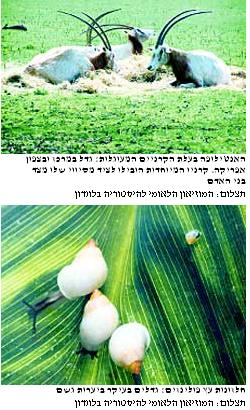By Yuval Dror Ha'Artez

https://www.hayadan.org.il/antelopedna.html
The new project of the National History Museum in London seeks to be the modern equivalent of the biblical "Noah's Ark". The purpose of the project, which was launched yesterday, is to collect and preserve the tissues and genetic material (DNA) of animals in danger of extinction. At this stage it is still not possible to clone the animals in question, but the scientists hope that in the future a way will be found to bring them back to life - if they become extinct.
Thousands of animal species are on the endangered species list. A report recently submitted to the UN states that 1,130 species of mammals and 1,183 species of birds are in danger of extinction. A study published at the beginning of the year in the journal "Nature" presents an even more difficult picture. The researchers determined that global warming will lead to the extinction of more than a million species and varieties of animals and plants growing on the globe in about 50 years, due to climate changes that will occur in the environment where they live.
The initiators of the project decided to preserve the genetic information of the extinct species before it was too late. As part of the project, several species will be frozen in their entirety (for this reason the project was nicknamed the "frozen Noah's Ark"), but in most cases, tissue samples will be taken from the animals, so that the scientists can continue to study them even if they become extinct. To avoid a situation where all the information is in one place, some of the samples will be stored in the History Museum in London, while others will be stored elsewhere.
"Many species are going extinct at an alarming rate," said Philip Rainbow from the museum in an interview with the British "Guardian". "We hope that if we save the tissues of the animals we can one day transplant them into other animals, which will serve as surrogates, and in some way it will be possible to bring the extinct species back to life. It may sound imaginary, but it will be a great shame if in 40 years scientists say to themselves, 'Look at what we can do today (from a technological point of view - XNUMX), why didn't we preserve the tissues of extinct animals?'"
Several tissues of extinct animals have already been deposited in Noah's frozen ark, including the tissues of the antelope with the rounded horns, the pigeon from Susuru Island, a coral fish known as Hashmanon, a smooth seahorse and more.
In recent years, attempts have been made to bring extinct animals back to life - but without success. In Australia, for example, scientists tried to connect pieces of DNA from the Tasmanian tiger that went extinct 65 years ago and the Moa, a bird that went extinct 400 years ago. In 2001, scientists tried to clone the Gaur - a wild bull that lives in the forests of India, Burma (Myanmar) and Nepal. The Gaor population has dwindled due to deforestation. The scientists took a nucleus extracted from a male gaur's cell and fused it with a denucleated cow's egg. The egg was implanted in the uterus of a surrogate cow. The offspring was born and died two days later, from infection; It is not clear if it is related to the cloning process. This failure does not prevent Japanese scientists from trying to bring back to life the hairy mammoth, a close cousin of the elephant, which became extinct ten thousand years ago.
Extinct and endangered animals
Dodo: A bird that cannot fly. Last seen in 1681
Polynesian wood snails: grow mainly in rainforests
The rounded-horned antelope: grows in central and northern Africa. His special horns led to his massive hunting by humans
Courtesy of Walla
